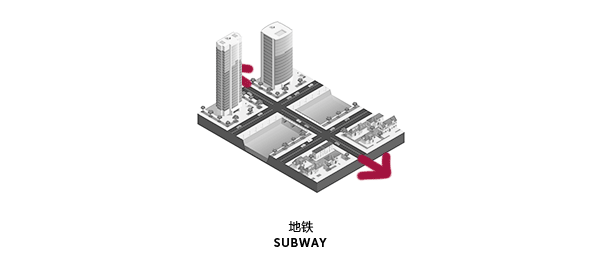
Instead of expanding the existing multi-lane highways to accommodate traffic, shrink it. The design of a multi-layered infrastructure allows more fluid transport, and would also serve as a starting point of an organic smart city.
Sections above and below the highway would be utilized for greenery and public amenities to make use of space. Sections implemented above would snake through buildings, allowing pedestrians and drones to have easier, straightforward pathing. Multimodal transit systems allow travel time from one area to the next within 15 minutes. Additionally, it reduces the city’s dependence on cars by offering multiple transit hubs and shared vehicles at each intersection.

Utilizing the space left open under highways, cultural centers and parks will be distributed to celebrate art and design, as well as allowing people to connect.

Recycling, the process of turning old used materials into new ones. A universal community effort which reduces the exploitation of natural resources, greenhouse emission, and pollution and waste.
Most of the waste comes from unnecessary packaging. Only 11% of China’s plastic is recycled and over 80% of the ocean plastic is uncollected waste. A better collection infrastructure could reduce leakage by 50%. Regulating dump sites and implementing better trash separation systems are efforts that could be made. Ensuring more waste getting recycled protects the environment for future generations.

Automated technologies like drones are an essential part of future technology. Today drone delivery is already on the works of being implemented to transport packages, food, or other goods. As this technology develops, dedicated drone runways will be opened, and hollow spacing within buildings will allow drones to fly through for easy pathing.

Small, beautiful, and efficient. Small-office spaces already exist today with diverse and interesting designs. Expanding this to a global network helps connect people, places and amenities. This would be a place to live, work, and play.

Vertical forest towers are already taking shape around the world by the Italian architect Stefano Boeri. The emission of carbon dioxides is one of the causes behind global warming. By bringing forests into cities, we are “fighting the enemy on its turf, and transforming carbon dioxide into a fertilizer to feed plants”, says Boeri.
With the construction of forest cities already on-going/completed in Switzerland and Milan, China’s region Liuzhou is next. Not only would the city’s streets and parks be covered in trees and plants, but the buildings too. A total 40,000 trees and almost one million plants, consisted of over 100 different species, are planned. It is estimated to absorb 10,000 tons of CO2 and 57 tons of pollutants each year, while also generating 900 tons of oxygen.